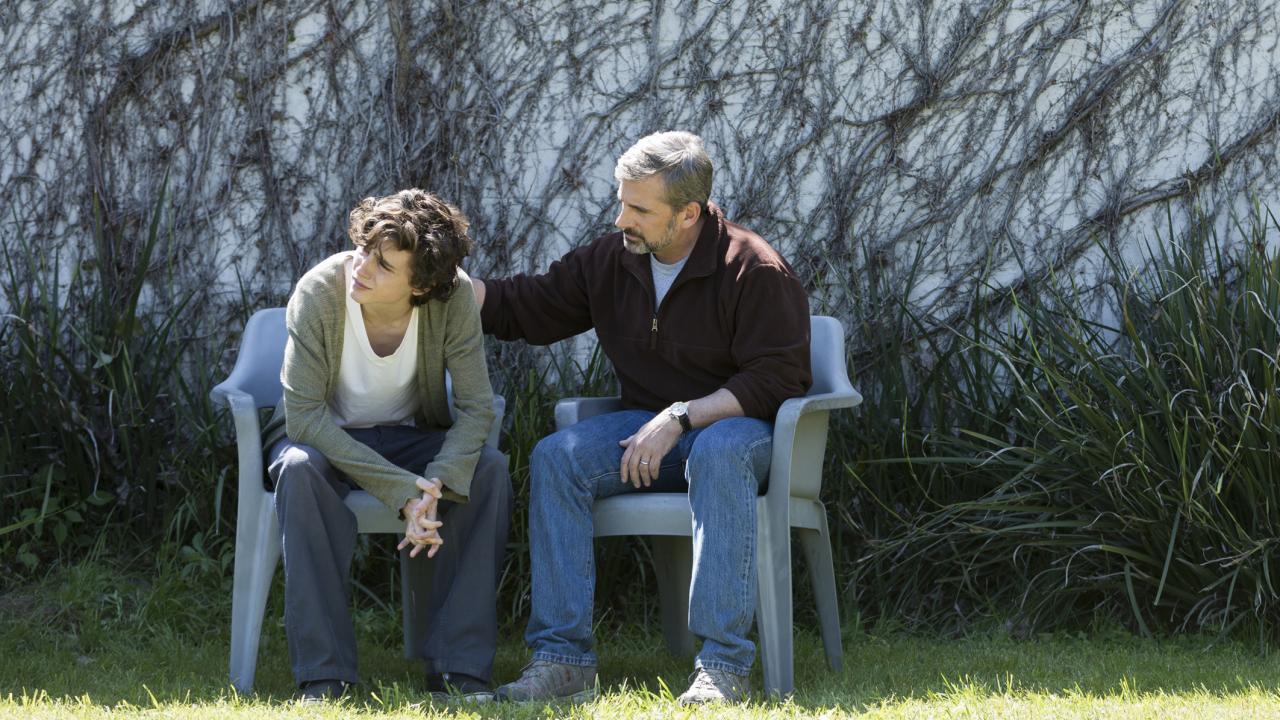Kategorie: Filmbesprechung
"Beautiful Boy"
Nic is 18 and addicted to crystal meth. His father David supports him in getting clean, but feels impotent after several relapses. The film by Felix Van Groeningen adapts two successful non-fiction books about struggling with drug addiction.

Unterrichtsfächer
Thema
Many "drug films" tell their stories from the perspective of the directly affected persons, from apparently harmless beginnings to the descent into addiction and the question of whether they will succeed in kicking the habit or relapse. Until now, most films have only skirted around consequences of the individual's addiction for the family as a whole. Most of them focus on the "classic" drugs – alcohol, heroin or cocaine – it is only in recent decades that movies and series such as Zum Filmarchiv: "Winter's Bone" (Debra Granik, USA 2010) or "Breaking Bad" (Vince Gilligan, USA 2008-2013) have examined the devastating effects of other substances, such as the synthetic drug crystal methamphetamine, known colloquially as crystal meth.
A Young Addict from an Upper Middle Class Background
Nic Sheff (Timothée Chalamet), the son of prominent journalist David Sheff (Steve Carell), also starts taking this drug around the age of 18. He appears to act out of a deep-seated fear of an inner emptiness, which his family cannot understand. This fear would appear to have haunted him as a child and crept into his consciousness as he reached adulthood. Facing down the anxiety or overcoming it with the help of his family do not seem to be options for him. Nor do we find out what may have caused this existential fear during his childhood. Ultimately, Nic turns to illegal drugs, first out of curiosity, then in a bid to flee from his own anxieties. His father David, his mother Vicky, and David's new wife and family, appear powerless as the boy drifts further into dependence. Time and again, his relapses after yet another stint in the rehabilitation clinic are excused as 'part of the therapy' until it eventually becomes clear that there is no way of helping him. The battle fought by father-and-son against Nic's drug addiction covers ten agonizing years.
In 2005, the real-life writer David Sheff published an article in the New York Times Magazine about his drug-addicted son, which was later to develop into the book Beautiful Boy. At the same time, his son wrote a book detailing his experiences, entitled Tweak. The Belgian director Felix van Groeningen was so fascinated by this father-and-son relationship and the books it produced that he decided to make a film about it – the first film he shot in the US.
Multi-Layered Narrative with Frequent Flashbacks
One of the difficulties of the adaptation was to combine the different memories of father and son into one coherent story rather than giving the impression of constantly jumping from one perspective to another. The screenplay by Felix van Groeningen and his co-author Luke Davies, who also has a heroin addiction behind him, solves this problem by telling parts of the story from the father's perspective only and others solely from the son's point of view. Original songs from the era (the 1990s), which were equally significant for both father and son, build an emotional bridge. The narrative technique of "Beautiful Boy" thus becomes a multi-layered montage of memories, whereby the father tells his story in a series of flashbacks that are not always in chronological order, while his son always remains rooted in the respective moment of the narration. In the process, the impressive lighting generates an atmosphere of uncertainty. The characters are often shown back-lit in front of a window, which leads to their faces being under-exposed, corresponding with their incomplete memories of the events in question.
The "Dual" Perspective …
The skillfully realized montage technique, the director's obvious respect for the well-known family and the sometimes stylized portrayal of drug consumption and rehabilitation efforts perhaps help to explain how the film manages to sidestep some important questions despite offering numerous factual details. As a result, the focus on the family is both a strength and a weakness of the movie. The "dual" perspective adopted in the film often merely hints between the lines that, despite the best of intentions, things did not always go well in the relationship between father and son and that the father's memory may be somewhat rose-tinted. Once research conducted by David Sheff demonstrates that the chances of curing an extreme crystal-meth user are minimal, it might have made more sense to explain why the son makes it anyway, just when his father was giving up, rather than merely pointing to a miracle.
… and the "Half-Truth"
With its focus on the fate of a young man from a privileged background, "Beautiful Boy" suggests that drug abuse is a disease that can affect any family. This is not wrong in itself, but it is also only "half" the truth. The socio-political reasons for the high levels of drug-related crime and drug addiction in the US – such as poverty and segregation in the major cities, widespread abuse of medication and young veterans' addiction struggles after military campaigns – get no mention in this story. According to a study by the Centers for Disease Control and Prevention (CDC), 70,237 people died of drug overdoses in the US in 2017, of whom more than 10,000 were died after using psychostimulants such as crystal meth. The number of drug-related deaths has reached alarming levels in the US and as a proportion of the population, is 14 times higher than in Germany.
Despite these criticisms, "Beautiful Boy" remains an important film and, especially in artistic terms, is well worth seeing. Its points of friction make it especially suited to a differentiated treatment in class. However, the film’s omissions should not be wept under the carpet.






